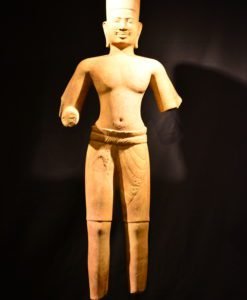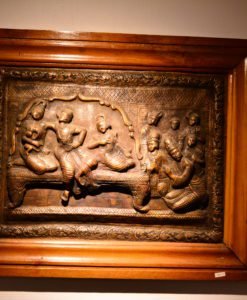Singha Guardian Statue – Angkor Wat Period (1113–1150 CE) Sandstone Sculpture, 31cm
In the sacred geometry of Khmer temple architecture, few figures possess the timeless symbolic gravity of the Singha, the guardian lion. This 31-centimeter sandstone sculpture, dating to the Angkor Wat period (1113–1150 CE), embodies the essence of divine protection in a form that is both fierce and refined. While smaller in scale, this freestanding piece holds the aura of monumental grandeur—a sentinel carved not merely for defense, but for cosmic harmony at the threshold of the sacred.
ITEM DESCRIPTION
Form and Function: An Architectural Guardian
Sculpted during the reign of King Suryavarman II, the builder of Angkor Wat, this Singha statue represents a semi-seated lion, poised in alert readiness. The posture, reminiscent of a crouching dog, was an intentional iconographic choice to embody both stillness and sudden power—a visual invocation of vigilance. These statues were often installed in pairs at entranceways of temples, palace gates, or ceremonial avenues, guarding the thresholds between the human world and divine sanctuaries.
The compact form and size of this statue suggest it may have stood either at a subsidiary entrance or served as part of a smaller sanctuary within a broader temple precinct, offering protection to sacred interiors.
Mane and Minimalism: Khmer Stylistic Restraint
One of the most intriguing features of this Singha is its stylized mane, rendered not in swirling curls or flame-like tufts seen in earlier Bakheng-period lions, but rather in three distinct rows of semi-rounded, square-like forms, subtly reminiscent of flattened beads or bread rolls—a minimalist interpretation likely meant to echo the stylized jewelry or celestial halos seen on other deities of the era.
Unlike heavily adorned figures from earlier periods, this Singha lacks overt jewelry or ornamental patterning, a trait reflective of the Angkor Wat period’s evolving visual language, which shifted toward balanced symmetry, spiritual clarity, and a deepening abstraction of divine forms. This absence is not a lack but a philosophical statement: in removing excess, the sculptor reveals essence.
Material and Craftsmanship
Carved from smooth, fine-grained sandstone—the signature material of Angkorian statuary—this piece exhibits a high level of surface refinement with minimal tool markings, suggesting a practiced artisan’s hand. The light brown tonality, combined with the sculpture’s preserved condition, hints at careful historical placement—likely sheltered or partially embedded within architectural surroundings.
The tail curling along the side, rendered with restrained movement, and the freestanding base confirm that this sculpture was made to stand independently rather than be embedded or mortised into larger structures—rare for guardian figures of this scale.
Iconography: Sacred Ferocity and Threshold Power
While the facial expression lacks the exaggerated snarl seen on some larger Singha, the angular jaw, subtly exposed teeth, and firm stance evoke the same unwavering protective intent. The Singha is not meant to frighten intruders but to radiate controlled power, acting as a metaphysical guardian against chaos, impurity, and bad fortune.
The Singha’s mythic significance spans Buddhist and Hindu traditions. As a protector of the Dharma, it symbolizes both the voice of authority and divine royal power. During the Angkor Wat period, its integration into temple design served both ritual and aesthetic purposes, blending cosmic symbolism with architectural harmony.
Cultural Context and Rarity
By the 12th century, Khmer sculptors had reached a pinnacle of iconographic mastery, synthesizing older motifs with innovative abstraction. This Singha reflects that synthesis—neither fully naturalistic nor wholly abstract, but a convergence of symbolic essence and formal clarity. Unlike later post-Bayon period pieces, which tended toward excessive decoration and denser composition, this Angkor Wat-period Singha conveys elegance through simplicity.
At only 31 cm in height, this piece is rare. Most Singha of this period were either monumental or fragmentary. A freestanding guardian of this quality and proportion, maintaining stylistic integrity without signs of heavy damage or erosion, is an exceptional survival.
Collector Significance
For collectors of Southeast Asian antiquities, this statue presents not only a historical artifact but a spiritual relic—a guardian who once stood watch over sacred rites. Its compact form, powerful symbolism, and quiet elegance make it ideal for private sanctuaries, scholarly collections, or curated exhibitions exploring the evolution of Angkorian temple iconography.
References
-
Freeman, M. and Jacques, C. (2006). Ancient Angkor. Bangkok: River Books.
-
Jessup, H. I. and Zéphir, T. (1997). Angkor and the Khmer Civilization. New York: Art Media Resources.
-
Bautze-Picron, C. (2010). The Buddhist Murals of Pagan: Timeless Murals in a Changing Landscape. Bangkok: River Books.
-
Rooney, D. (2006). Khmer Ceramics and Bronzes: Beauty and Meaning. Bangkok: The Siam Society.
Origin: Cambodia
Period: Angkor Wat
PRODUCT DETAIL
Medium: Sandstone
Dimensions:
Height 31 cm
Length 17 cm
Wide 17 cm
Condition Report: –
Please keep in touch for Price and more information: Mallika1013@gmail.com
























